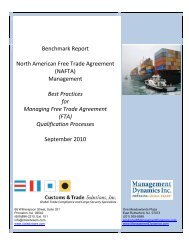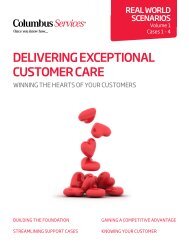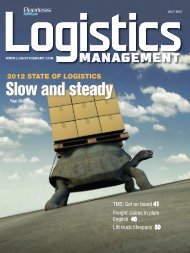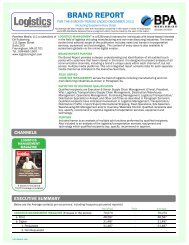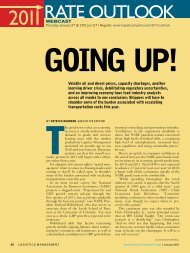Logistics Management - June 2010
Logistics Management - June 2010
Logistics Management - June 2010
Create successful ePaper yourself
Turn your PDF publications into a flip-book with our unique Google optimized e-Paper software.
Managing Risk, continued<br />
Talk about the technology that is<br />
Q: leading the way these days when it<br />
comes to risk management.<br />
One significant trend is an expansion<br />
of the tracking systems that<br />
A:<br />
are in place, whether they’re specific<br />
technologies, whether it’s GPS or<br />
RFID, which is used to obviously track<br />
the efficiency. It’s also taking things<br />
that are used in the logistics industry,<br />
expanding that to incorporate some of<br />
those risk factors beyond what is perceived<br />
as the daily tolerance for problems.<br />
Predictive analysis tools are then<br />
used to better forecast risk, such as<br />
security and shrinkage. So those types<br />
of systems and the expanded use of<br />
those systems or other applications to<br />
track and to be part of a trade-recovery<br />
or a commerce-recovery process if you<br />
have failure.<br />
So it is possible to take an existing<br />
Q: system and maybe add modules to<br />
it rather than having to rip everything<br />
out and start from scratch<br />
Absolutely. And some of the<br />
A:<br />
architecture really has to be challenged.<br />
So if you’ve got an ERP system<br />
that’s looking at things in a modular<br />
fashion, then instead of designing<br />
the risk elements into each<br />
of the modules, you need the<br />
capability to look across multiple<br />
modules. You need to be<br />
able to look at the flow of the<br />
product, the information, and<br />
the cash to see again where you<br />
are going to have the greatest<br />
risk.<br />
You also believe demand<br />
Q: should trump supply when<br />
it comes to risk management.<br />
Your book talks about healthcare<br />
and vaccinations for H1N1.<br />
But demand is so volatile, especially<br />
with something like that.<br />
You can go for months without<br />
needing anything and then all<br />
of a sudden you need millions<br />
of doses right now. How do you<br />
handle that kind of volatility<br />
without building up massive<br />
inventory<br />
I think it starts with the<br />
fundamentals. As we’ve<br />
A:<br />
seen before, we need systems. The<br />
tendency when looking at the demand<br />
side, especially through a risk lens, is<br />
to look at the threats to the demand.<br />
In other words, threats as they relate<br />
to the buyers, threats as they relate to<br />
the market itself. Now, that’s OK, but<br />
there are just too many variables there.<br />
So from the demand side, that means<br />
understanding the impact of demand<br />
significantly changing or being volatile,<br />
and translating that into looking at<br />
failure of demand or looking at a huge<br />
uptick in demand, and then starting to<br />
understand what each inflection point<br />
translates into from a risk standpoint.<br />
What is your threshold or tolerance<br />
before the risk becomes a real concern<br />
Doing all that requires you to understand<br />
all the variables in the supply<br />
chain that supports that product.<br />
So for, say, a bottle of water. If the<br />
demand at a particular threshold is<br />
going to tax your ability to get a hold of<br />
certain resins, it really starts to change<br />
the decision about how you manage<br />
risk, how you manage the supply chain<br />
for that particular bottle of water. But<br />
when you do the analysis and you start<br />
to say, well, I’ve now been able to look<br />
The 10 Laws of Supply Chain<br />
Risk <strong>Management</strong><br />
1. if you don’t manage and lead change, you have to<br />
surrender to it.<br />
2. the paradigm should destroy the parasite; begin by<br />
defining the paradigm, not fighting the parasite.<br />
at these thresholds, plot all these different<br />
impacts that you have at different<br />
levels. As you plot these things on<br />
a chart, you can see what parts of the<br />
product are going to cause you more<br />
pain or less pain. It could be products<br />
that are used in the production process,<br />
such as certain gases, or it could be<br />
availability of materials that are actually<br />
part of the product.<br />
Is it possible to go overboard with<br />
Q: risk management and, if so, where<br />
do you draw that line<br />
It’s absolutely possible to go over<br />
A:<br />
3. Manage your business Dna in a Petri dish of evolving<br />
risk.<br />
4. in supply chain risk management, demand trumps<br />
supply.<br />
5. Never set up your suppliers for failure.<br />
6. Managing protection risk is a dirty job; focus on<br />
managing the endless risk of manufactured weakest<br />
links.<br />
7. the logistics risk management rule—Managing the<br />
parts does not equal managing the whole.<br />
8. Mitigation—If supply chain risk management isn’t<br />
part of the solution, it will become the problem.<br />
9. Financing—The best policy is knowing what’s in your<br />
policy.<br />
10. Manage the risk as you manage your own; your<br />
supply chains are all interdependent but unique.<br />
the top from a risk-management<br />
standpoint where you find out that<br />
the risk management has slowed your<br />
speed or slowed your service or impacted<br />
your ability to innovate. That’s why<br />
I think it certainly needs to be layered<br />
in and integrated, and most importantly<br />
measured. The challenge is doing that,<br />
trying to get to the point of the balance.<br />
But in answer to your question,<br />
yes, I think we can over-control the<br />
risk. That happens when the measures<br />
and the metrics aren’t in place where<br />
you’re not measuring impacts, where<br />
you’re trying to chase different threads<br />
and you believe a particular<br />
thread is more important than<br />
another thread. When you take<br />
the shortcuts on the measurement<br />
side from an impact and<br />
investment standpoint, I think<br />
that’s where you really start to<br />
get in trouble and you get out<br />
of whack with the ultimate<br />
decision process. And when<br />
you do that and you measure<br />
it, the person that’s conducting<br />
the analysis is not the decisionmaker,<br />
and they have to bring<br />
that data forward so that the<br />
real decision-makers can do<br />
what they do every day in business.<br />
So talking about the leaders<br />
Q: in supply chain and risk<br />
management, who’s leading the<br />
pack What industries<br />
The ones that really jump<br />
A: out are some of the larger<br />
high-tech manufacturing companies,<br />
especially those that<br />
36 <strong>Logistics</strong> <strong>Management</strong> WWW.LOGISTICSMGMT.COM | <strong>June</strong> <strong>2010</strong>




